In the 20 years since September 11, 2001, the United States has spent more than $2 trillion on the war in Afghanistan. That’s $300 million dollars per day, every day, for two decades.
Or $50,000 for each of Afghanistan's 40 million people. In baser terms, Uncle Sam has spent more keeping the Taliban at bay than the net worths of Jeff Bezos, Elon Musk, Bill Gates and the 30 richest billionaires in America, combined.
Those headline numbers include $800 billion in direct war-fighting costs and $85 billion to train the vanquished Afghan army, which folded in the weeks since the Pentagon’s sudden early July closure of Bagram Air Force Base eliminated the promise of air support against the advancing Taliban.
U.S. taxpayers have been giving Afghan soldiers $750 million a year in payroll.
All told, Brown University’s Costs of War Project estimates the total spending at $2.26 trillion.
And the costs are even greater in terms of lives lost.
There have been 2,500 U.S. military deaths in Afghanistan, and nearly 4,000 more U.S. civilian contractors killed.
That pales beside the estimated 69,000 Afghan military police, 47,000 civilians killed, plus 51,000 dead opposition fighters.
The cost so far to care for 20,000 U.S. casualties has been $300 billion, with another half-trillion or so expected to come.
We’ll keep incurring costs long after President Biden's pullout from Afghanistan is complete. Naturally, the United States has financed the Afghan war with borrowed money.
Brown University researchers estimate that more than $500 billion in interest has already been paid (included in the $2.26 trillion total sum), and they figure that by 2050 the cost of interest alone on our Afghan war debt could reach $6.5 trillion. That amounts to $20,000 for each and every U.S. citizen.
Videos taken from the tarmac of the Kabul airport indicate that the 6,000 U.S. troops sent there have not been able to establish a perimeter even around the runways, . .



No comments:
Post a Comment